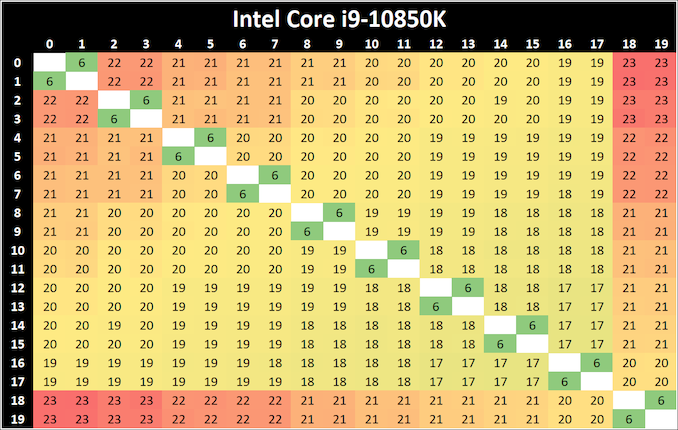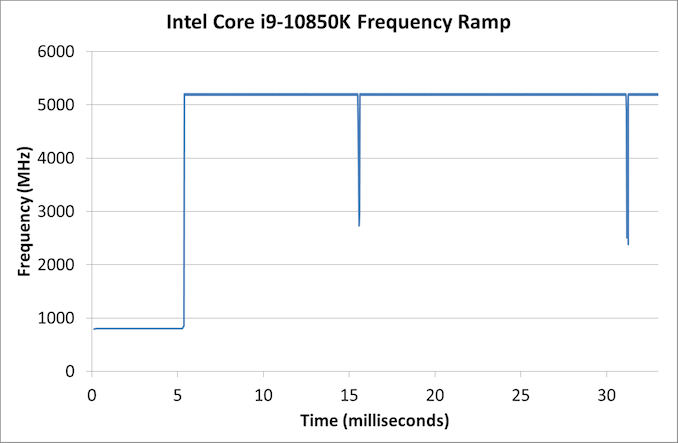Intel Core i9-10850K Review: The Real Intel Flagship
by Dr. Ian Cutress on January 4, 2021 9:00 AM EST- Posted in
- CPUs
- Intel
- Core
- Z490
- 10th Gen Core
- Comet Lake
- LGA1200
- i9-10850K
CPU Tests: Microbenchmarks
Core-to-Core Latency
As the core count of modern CPUs is growing, we are reaching a time when the time to access each core from a different core is no longer a constant. Even before the advent of heterogeneous SoC designs, processors built on large rings or meshes can have different latencies to access the nearest core compared to the furthest core. This rings true especially in multi-socket server environments.
But modern CPUs, even desktop and consumer CPUs, can have variable access latency to get to another core. For example, in the first generation Threadripper CPUs, we had four chips on the package, each with 8 threads, and each with a different core-to-core latency depending on if it was on-die or off-die. This gets more complex with products like Lakefield, which has two different communication buses depending on which core is talking to which.
If you are a regular reader of AnandTech’s CPU reviews, you will recognize our Core-to-Core latency test. It’s a great way to show exactly how groups of cores are laid out on the silicon. This is a custom in-house test built by Andrei, and we know there are competing tests out there, but we feel ours is the most accurate to how quick an access between two cores can happen.
When we first reviewed the 10-core Comet Lake processors, we noticed that a core (or two) seemed to take slightly longer to ping/pong than the others. We see the same pattern here again with the final core.
Frequency Ramping
Both AMD and Intel over the past few years have introduced features to their processors that speed up the time from when a CPU moves from idle into a high powered state. The effect of this means that users can get peak performance quicker, but the biggest knock-on effect for this is with battery life in mobile devices, especially if a system can turbo up quick and turbo down quick, ensuring that it stays in the lowest and most efficient power state for as long as possible.
Intel’s technology is called SpeedShift, although SpeedShift was not enabled until Skylake.
One of the issues though with this technology is that sometimes the adjustments in frequency can be so fast, software cannot detect them. If the frequency is changing on the order of microseconds, but your software is only probing frequency in milliseconds (or seconds), then quick changes will be missed. Not only that, as an observer probing the frequency, you could be affecting the actual turbo performance. When the CPU is changing frequency, it essentially has to pause all compute while it aligns the frequency rate of the whole core.
We wrote an extensive review analysis piece on this, called ‘Reaching for Turbo: Aligning Perception with AMD’s Frequency Metrics’, due to an issue where users were not observing the peak turbo speeds for AMD’s processors.
We got around the issue by making the frequency probing the workload causing the turbo. The software is able to detect frequency adjustments on a microsecond scale, so we can see how well a system can get to those boost frequencies. Our Frequency Ramp tool has already been in use in a number of reviews.
The Core i9-10850K ramps up extremely quickly from idle to peak turbo, in the region of about 5 milliseconds. This is faster than the 16 ms we typically observe.












126 Comments
View All Comments
Machinus - Monday, January 4, 2021 - link
Put that piled higher and deeper to use and write an article about how binning affects IC design, before the variability in lithography. Other PhDs read this site tooFreckledTrout - Monday, January 4, 2021 - link
Its the top chart on the the second page. The AIDA stress tests where we are looking at around 260 watts.Machinus - Monday, January 4, 2021 - link
There's a whole article in the chart?j@cko - Monday, January 4, 2021 - link
Nice try Intel. This reminded us of AMD during those FX days when they had nothing good to compete with Intel. Intel's complacency has proven to be quite costly and made some consumers quite bitter toward them. It's gonna take some time to fix that and win back consumer trust and confidence. For example, our company has switched to buying AMD (Ryzen) system since Zen+ and they do not plan on going back to Intel unless AMD goes rogue (complacent with tech and price). Even at my own household, we have built 5 or 6 systems and none of them are Intel.DannyH246 - Monday, January 4, 2021 - link
Yawn. More Intel crap.Desierz - Monday, January 4, 2021 - link
I wonder what Rocket Lake temps will be like..goatfajitas - Monday, January 4, 2021 - link
hotGrayswean - Monday, January 4, 2021 - link
Hence the name.Deicidium369 - Monday, January 4, 2021 - link
same as here if you use the same janky passive HSFzodiacfml - Monday, January 4, 2021 - link
why even work on this? Ryzen 5000 series?